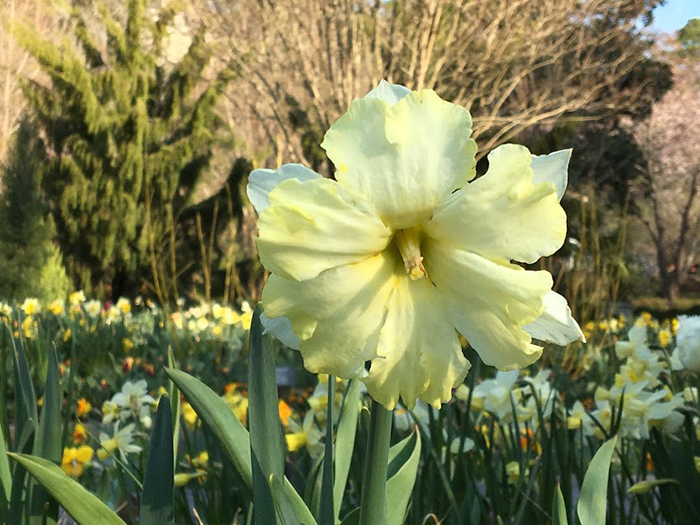Garden Talk
Horticultural Highlight: Split Corona Daffodil
In this series, the staff of Duke Gardens highlights plants you’ll find within our 55-acre living collection. This week, assistant horticulturist Mandy Cuskelly talks about her favorite daffodil in the Terrace Gardens, Narcissus ‘Cassata’.

Botanical name: Narcissus ‘Cassata’
Common name: Split corona daffodil
Family name: Amaryllidaceae (Amaryllis Family)
Plant type: Bulb
Native range: Northern Europe
Location in Duke Gardens: Terrace Gardens
Site requirements: Full sun
USDA Hardiness Zones: 3-8
I work in the Historic Gardens, meaning I spend a lot of time looking at bulbs. This fall, we planted 54,000 bulbs in the terraces. Over the past two years, we have planted 87 different types of daffodils. The fact that this daffodil is my favorite and I still stop to look at it each time I walk by really means something!
If you don’t spend much time with daffodils, they may all seem similar. But they are split into classes based on flower characteristics. According to the Royal Horticultural Society, Narcissus ‘Cassata’ is classified as a Division 11 Split Corona daffodil cultivar, meaning the petals closest to the center are not one single piece but split into several that flare outward.
This daffodil blooms early for us in this area, usually making its appearance in late February to early March. The corona of this daffodil is a bright yellow when it opens, and as the flower ages it ends up a buttery white. You can see the difference in these pictures.
Like all daffodils, this plant is a perennial bulb. You can plant the bulb once and enjoy daffodils for years to come. In fact, if you visit old homesteads, the houses may be gone but the daffodils will still be carrying on.
To plant, dig a hole twice the height of the bulb, make sure you have the bulb facing up, and then fill in the hole. Once the flowers have finished, it is important to leave the foliage until it turns yellow and withers. Those green leaves replenish nutrients lost when blooming and create a food store for next year’s flowers. If the leaves are cut prematurely, you may very well see smaller flowers or no flowers the following year. Don’t despair—leave the foliage alone that year and you should be back to enjoying flowers the year after. An added bonus: daffodils are toxic to deer, so deer leave them alone.
If you want to read more about how daffodils are classified, I recommend the Daffodil Society in the U.K., and The American Daffodil Society.

Photos by Mandy Cuskelly.






